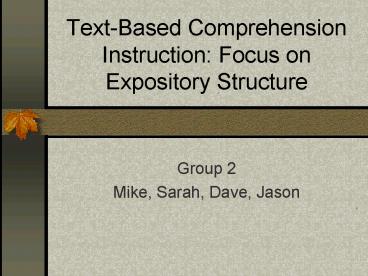TextBased Comprehension Instruction: Focus on Expository Structure - PowerPoint PPT Presentation
1 / 11
Title:
TextBased Comprehension Instruction: Focus on Expository Structure
Description:
Research has shown that readers who use an author's organizational pattern, a ... Less familiar for young readers than narrative text. First Step is Planning ... – PowerPoint PPT presentation
Number of Views:71
Avg rating:3.0/5.0
Title: TextBased Comprehension Instruction: Focus on Expository Structure
1
Text-Based Comprehension Instruction Focus on
Expository Structure
- Group 2
- Mike, Sarah, Dave, Jason
2
Expository Structures
- Research has shown that readers who use an
authors organizational pattern, a pattern guide,
to structure their memory for reading are able to
recall more than those who do not.
http//www.ncsd.k12.pa.us/pssa/Reading/rihand13.ht
m
3
Pattern Guides
- 1. Identify a few important concepts in the text
to be taught. - 2. Determine the expository pattern used by the
author. - 3. Make a chart or diagram for the students to
complete that represents the text organization
and the important concepts to be learned.
4
Pattern Guides
- 4. On an overhead projector, model for students
how to use the guide with the first paragraph or
two of the text. - 5. Make sure the printed directions provided on
the pattern guides are clear and understandable. - 6. After modeling, distribute the pattern guides
for independent use.
5
Concept-Text-Building
- Developed as a structure to improve comprehension
of expository text. - Assumptions of for Context-Text-Building
- Build on students existing background of
knowledge - Expository text requires special instructional
attention - Less familiar for young readers than narrative
text
6
First Step is Planning
- Under planning there is three steps
- The teacher reads the book
- The teacher rereads the text to look for major
points, questions, or vocabulary - Thinking of ways that the information being
learned can be related to other curriculum areas.
7
Second Concept Assessment and Development
- Getting the students attention right away is
needed to engage the students. - Ask questions before that let them share
background information or imaginative ideas. - Then ask questions that would focus on the
critical concepts and vocabulary that they may
not already know.
8
Three Text
- The teacher and students engage in guided
reading. - Questions and discussions help to decide the
purpose of each segment read. - Next alternate purpose setting, silent reading,
and discussion for each segment of the text.
9
Text Continued
- A visual organizer is used to direct reading and
discussion toward filling in the organizer. - As each segment of the text is finished,
information is added to the organizer. - When all the significant information is
presented, lines are drawn on the organizer to
show the relevance of certain topics to other
topics on the organizer.
10
Fourth Application
- After the organizer is finished, the teacher
helps the students draw relationships between the
text and their own previous knowledge of the
subject. - Proceeding the discussion, the teacher may have
the students participate in extension activities.
11
References
- Teaching Children to Read Putting the Pieces
Together (Third Edition) - Diagnostic Teaching of Reading Techniques for
instruction and assessment - http//www.ncsd.k12.pa.us/pssa/Reading/rihand13.ht
m































